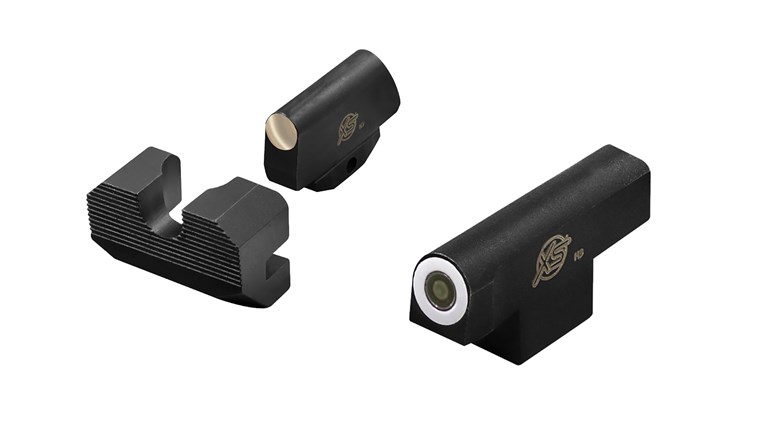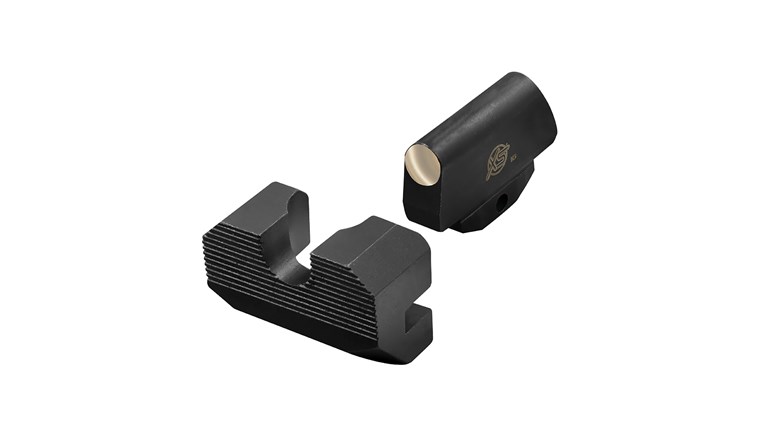
Having handgun sights that are properly regulated, or sighted in, is essential if you want to reliably hit a target. Unfortunately, a fairly low percentage of handgun shooters understand how to accomplish this task. It is also a relatively common practice for a gun store employee to install a new set of sights on a customer’s pistol and then hand it back across the counter without ever firing a shot.
The customer likely leaves the store assuming the pistol will shoot to point of aim, and never bothers to shoot it to find out. After all, they were installed by a professional. Just because a set of sights come in the same package and are installed roughly in the center of the slide, there is no guarantee that your handgun will hit where you expect it to.
There are several reasons that this can be the case, not the least of which is that the barrel tilts to lock and unlock in most semi-automatic pistols. I am a firm believer that the only way to ever know if a firearm’s sights are correctly zeroed is to shoot it!
While micro red dot sights are increasing in popularity, a majority of handguns are still equipped with notch-and-post type iron sights, so that is what we will discuss here.
Sights are a measuring device that helps us position the bore of the firearm so that our line of sight and bullet trajectory can repeatably coincide at a specific point. That specific point where point of aim and point of impact meet is our zero. People who have seen the drawing on an ammo box showing a rifle’s trajectory sometimes have the idea that bullets rise after leaving the muzzle. The truth is that they begin losing velocity, and therefore falling, the instant they leave the barrel.
The reason for the arc of trajectory is that we are elevating the muzzle to “lob” the bullet into the target. Sights allow us to measure that elevation. The bullet begins below the line of sight, crosses it once on the upward side of its arc, and then again on the downward side. While both coinciding points are important for rifles, for handguns we are usually only concerned with the first crossing.
I suspect that the reasons that shooters cannot regulate handgun sights fall into three categories: they do not understand the process; they don’t have the necessary tools; or they cannot shoot well enough to tell what corrections need to be made.
The Basics
In order to reliably sight in a handgun, the shooter must be able to shoot a decent group. If the shooter can only hold the shots into “minute of basketball” at the specified distance, then a 2-inch correction isn’t going to mean much. Depending somewhat on the type of handgun and application, it is fair to say that generally the shooter should be able to keep five shots in a 3-inch group at the sight in distance.
For general purposes, sight-in 20 yards seems about right, though the intended purpose of the firearm should be considered. Shorter distances can be used for smaller carry guns, and longer for hunting handguns. I find it better to shoot most handguns offhand rather than rested when zeroing. This is because shooting from a rest sometimes changes the point-of-impact more with a handgun than is usual with rifles.
Recoil begins to develop while the bullet is still traveling down the barrel. Having a handgun sandbagged rigidly changes the way it moves under recoil, and sometimes its point of impact. When using square iron sights, I find that most shooters produce better groups when using a square target rather than a round bullseye. A black square that is roughly the same width as the front sight at the prescribed distance works very well.
Notch-and-post iron sights are generally meant to be aligned so that the top of the rear sight is level with the top of the front, and an equal amount of light on either side of the front sight within the rear notch. Point of aim and point of impact are sometimes intentionally set as different points. It is a relatively common practice to sight in for a “6-o’clock hold”, especially when using round bullseye targets. The top of the front sight is aligned with the bottom of the bullseye rather than the center since it is easier to locate. This is also sometimes used to prevent the front sight from obscuring a portion of the target.
Windage is horizontal adjustment in the point of impact. Elevation is the vertical adjustment. Corrections can be made by adjusting the position of either the front or rear sight. When adjusting the rear sight, the sight must be moved in the direction that the group on the target needs to move. For example, if the group is low and left, the rear sight needs to move up and to the right. If the front sight is being adjusted, this is reversed. For example, if the group is low, the front sight can be shortened to adjust.
The amount of necessary movement of a sight to achieve the desired movement of the POI on target can be calculated with some relatively easy math. If you have an adjustable sight and a screwdriver at the range with you, it might be faster to simply move the sight a few clicks and shoot another group.
Do the Math
Speaking as a gunsmith, the upcoming math is a huge time saver! It can save a lot of trips between the shop and the range when adjusting fixed sights. Before starting, you need to know the distance from the muzzle to the target (converted to inches), and the sight radius of the handgun. Sight radius is the distance from the rear face of the rear sight to the rear face of the front sight.
The calculation works like this: sight radius/distance to target (in inches) then multiply by the amount of needed correction. For example, if you are shooting a 1911 with a 6.75-inch sight radius at 20 yards (720 inches), and getting groups that are 3 inches low, the result will look like this: 6.75/720=.00937. This means that to move the point of impact one inch on target, the sight needs to move roughly .009 (those extra digits are unnecessary in this discussion). Multiply .009 (nine thousandths in gunsmith speak) by the 3 inches of necessary correction, to find that the rear sight needs to be raised by .027. If the handgun in question has fixed sights, a .027 shorter front sight would accomplish the same thing.
Making Adjustments
Dovetails are used to affix a large percentage of handgun sights. This allows some windage adjustment for models with otherwise fixed sights. Drifting dovetail sights can certainly be done with a punch and a hammer, but great care must be taken to prevent damage to the sight, slide, or barrel. It is also tough to move something a precise distance by whacking it with a hammer.
A sight pusher is a much more precise way to move a sight, especially when trying to make a small adjustment. Mounting a dial indicator on the opposing side of the sight so that exact movement can be measured is a very accurate method. For those lacking this specialized tooling, a measurement made with a set of reloading calipers will usually suffice.
On fixed-sight revolvers, adjusting point of impact can be more of a challenge. For elevation, the front sight must either be shortened or replaced with a taller one. For windage, the barrel can be slightly torqued left or right in the frame depending on the necessary adjustment. This process usually requires specialized tooling, and the amount of movement of the front sight can be difficult to measure.
A common trap to fall into while regulating sights is to “chase” the sight in. The shooter makes a bad shot, then adjusts the sights based on the bad shot. Another bad shot follows, and another correction in a different direction. The cycle just gets repeated. Sight corrections should be based on good technique and hopefully on good groups that are repeatable.
Point-of-impact can vary when changing types of ammunition or bullet weights. Therefore, it is important to use the same load for sighting in that will be used most often afterward. Typically, heavy bullets hit higher than lighter ones coming out of the same gun. This seems to be more pronounced in revolvers. In a .44 Magnum for instance, a 200-grain bullet vs. a 300-grain one may have a full 6-inch difference in point of impact at 25 yards. This is likely due to the affects of recoil while the bullet is still inside the barrel.
Humans are very unique organisms that come in all shapes and sizes. When it comes to handgun shooting, we perceive sights and sight pictures differently. It is not unusual for a handgun sighted correctly for one shooter to shoot to a different point of impact for someone else. Having someone else verify that the sights are in the right ballpark is fine but shouldn’t be substituted for shooting the firearm yourself to be sure. Practical reasons aside, shooting is fun! Don’t shortchange yourself!




































